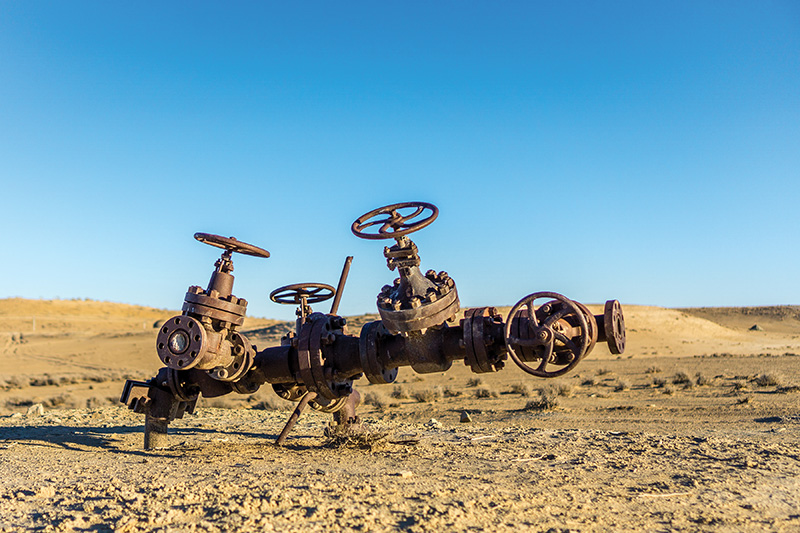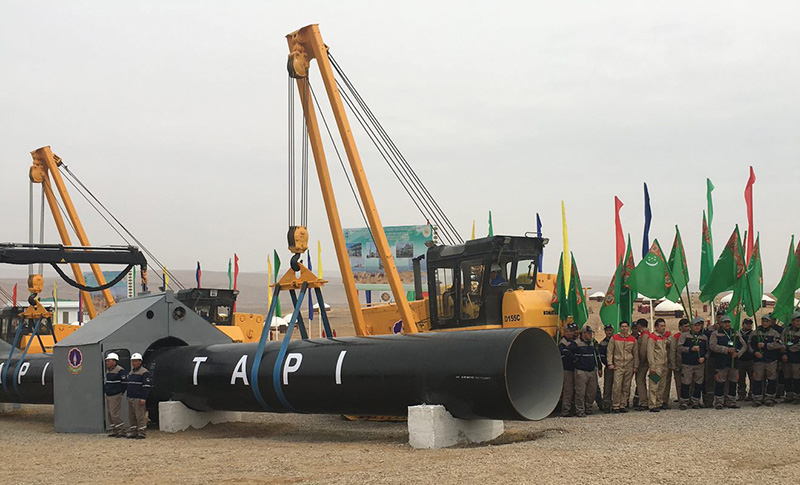September 2022, Vol. 249, No. 9
Features
Turkmenistan Pipe Dreams: Russia, China Both Make Overtures
By Gordon Feller, P&GJ Correspondent
(P&GJ) — Russia’s invasion of Ukraine has quickly transformed the West’s relationship with Russia. It’s forged Russia’s closer alignment with China. It seems that 2022 is becoming the year when everyone is rethinking the circles of power, especially in Eurasia.
Moscow’s estrangement from the West is not mirrored in Central Asia’s former USSR’s republics. One key republic on which many are now focused is Turkmenistan, in large part because this country possesses vast natural gas reserves.
Putin’s dream has been to bring Turkmenistan more tightly into his own orbit, but that is also China’s dream. For this reason, China’s leadership is making regular visits to the capital city of Ashgabat, discussing projects that would improve infrastructure, most especially ports and pipelines.
Russia is anxious to do the same, but with the current economic crisis, it’s burdened with an extremely limited range of motion. Turkmenistan’s leadership is also looking at the possibility of joining a trade bloc for the very first time.
The country has traditionally taken a conservative and neutral stance in joining regional trade and political blocs, but this may soon change. Turkmenistan’s president Gurbanguly Berdimuhamedow is not thinking about the European Union. Instead, his eyes seem to be set on the possibilities for of The Eurasian Economic Union (EEU). Instead, his eyes seem to be set on the possibilities for the Eurasian Economic Union (EEU).
EEU’s bloc occupies the geographic space between China and the European Union (EU), and it has a total gross domestic product (GDP) of about $5 trillion. EEU’s most recent Intergovernmental Council meeting was held in Kazan, and prime ministers attended from each one of the member states: Armenia, Belarus, Kazakhstan, Kyrgyzstan and Russia.
The Chairman of the Board of the Eurasian Economic Commission, Russia’s Mikhail Myasnikovich, made this statement before his government launched war against Ukraine: “The manufacturing output has increased by 9% in Belarus, 7.5% in Kazakhstan, 1% in Russia. In the current period of 2021 mutual trade between the EEU member states increased by 6.8%. It increased most significantly in Russia by 9.7%, Belarus by 3.9% and Armenia by 2.5%.”
Turkmenistan was an observer at the most recent Council meeting, with a delegation of Turkmenistan business leaders and politicians, all of it headed by Deputy Prime Minister of Turkmenistan and Chairman of the Supreme Control Chamber of Turkmenistan Serdar Berdimuhamedov.
In statements to the media, he and the Turkmen delegates made it clear that their country has resources that are of keen interest to these partner countries. The country’s GDP is $120 billion, and the population of nearly 6 million earns an average of $20,000 per annum per capita. All EEU member states know that cooperation with Turkmenistan could have a big impact on the region’s hydrocarbon business.
Turkmenistan is trying extremely hard to develop its transport and logistics infrastructure and has started by building a network of modern highways, bridges and interchanges.
The government is also funding construction at the Turkmenbashi International Seaport, which has a capacity of up to 25 million tons of cargo turnover per year. Together with foreign investors, railway lines, fiber-optic communication and power transmission lines were put into operation to the south of the country, while facilities for fuel and lubricant production have also been built.
Turkmenistan’s long-standing policy has been neutrality, and this has kept it out of Russia’s regional security arrangements: the Shanghai Cooperation Organization (SCO) and the Collective Security Treaty Organization (CSTO). This approach has constrained the level of influence Moscow has in this one central Asian republic. One result of this fact is that China is now on its way to becoming the dominant outside power in Turkmenistan’s economic life.
There are multiple reasons for Beijing’s rise, including Beijing preexisting and heavy involvement in Turkmenistan’s natural gas sector and transit routes through that country between China and Europe. But there are other factors:
- The threat of the Taliban to the wider Central Asian region is recognized as serious by both governments.
- Ashgabat is ready to support China on Xinjiang. Unlike others in Central Asia, Turkmenistan lacks a diaspora that is being victimized there.
- Beijing is interested to expand from economic involvement into security cooperation. In doing so, Beijing has beat out Moscow, positioning itself in ways that successfully compete with Turkey and other outside powers.
On a bilateral basis, Turkmenistan and Azerbaijan are drawing closer to one another. Heads of state have been meeting because they see themselves as key to the East–West trade corridor that has attracted billions of dollars of investment over the past few years, and media reported that this issue was also among the issues that they discussed.
The trip to Baku was a relatively rare overseas trip for Berdymukhamedov, although he has shown more interest in developing foreign ties to expand Turkmenistan’s gas trade routes.
“We defined priority areas of cooperation, in particular energy, transport, communications, chemical and textile industry, construction, technologies, service sector, etc.,” Berdimuhamedov said at a news conference following a recent meeting with Azerbaijani President Ilham Aliyev.
Further, Berdimuhamedov said Baku and Ashgabat reached agreement to coordinate efforts toward building East–West transport and transit corridors passing through the territories of both countries. “We also agreed to use port infrastructure of both Turkmenistan and Azerbaijan on the Caspian Sea.”
It was after this meeting that Azerbaijan, Afghanistan and Turkmenistan put their names to a new agreement about an old idea: the Lapis Lazuli Corridor. This new trilateral arrangement lays out a detailed roadmap for expanding Eurasian connectivity cooperation.
The corridor is structured as a multimodal, East–West flow, and it originates in Afghanistan, with overland routes passing through Turkmenistan. These are followed by ferry connections across the Caspian to Azerbaijan. From there, goods continue by rail to Georgia, Turkey and potentially on to Europe.
The first fleshed-out concept for this the project dates back 10 years. Such a route has been impassable because of the region’s economic and political instability, and the insufficient infrastructure. An agreement was signed in 2017, with the corridor’s opening ceremony convening a year later.
One area of special interest in the new trilateral agreement is resolving all the various issues that remove numerous barriers to the transportation of goods along the corridor – and a deepening of coordination on border and customs.
Once upon a time it was predicted that the Central Asia–China pipeline in Turkmenistan would be transporting 2.3 Tcf (65 Bcm) of Turkmen gas annually by 2020. The project to build a Trans-Afghan Pipeline to India, known as TAPI, was also supposed to have come into being by this time. Delays in both cases are only partly fruit of misfortune. Inertia and lack of investment have also played a big role.
The Central Asia–China Gas Pipeline began to be constructed in July 2008 and became operational on Dec. 14, 2009.
The pipeline starts at Gedaim on the border of Turkmenistan and Uzbekistan, running through central Uzbekistan and southern Kazakhstan. It ends at Horgos in China’s Xinjiang Uygur Autonomous Region, where it will be connected to the Second West–East Gas Pipeline.
In July 2007, China National Petroleum Corporation (CNPC) signed a production-sharing contract to explore and develop gas fields on the right bank of the Amu-Darya River with the Turkmen State Agency for the Management and Use of Hydrocarbon Resources and a natural gas purchase and sales agreement with Turkmengazi State Concern.
Then, CNPC signed two basic principal agreements on gas pipeline construction and operation with KazMunayGaz and UzbekNefteGaz, under the framework agreements on pipeline construction and operation between the Chinese government and the Kazakh and Uzbek governments.
Under the agreements, CNPC invested in a cross-border gas pipeline in Central Asia, through which Turkmenistan agreed to supply China with 1.1 Tcf (30 Bcm) of natural gas annually for 30 years.
The Central Asia–China Gas Pipeline has dual lines, each running for 1,140 miles (1,833 km). Line A became operational in December 2009 and Line B was operational at the end of September 2010. A delivery capacity of 30 Bcm a year was achieved by the end of 2011.
Aside from fostering economic cooperation between China and Central Asian countries, the pipeline will also be a source of prosperity for the region, promoting the development of and investment in local natural gas resources, stimulating the growth of local equipment manufacturing and construction industries, and creating employment opportunities. Construction of the project required more than 1.7 million U.S. tons (1.5 million metric tons) of steel.







Comments